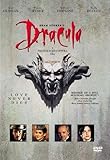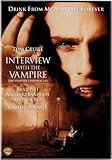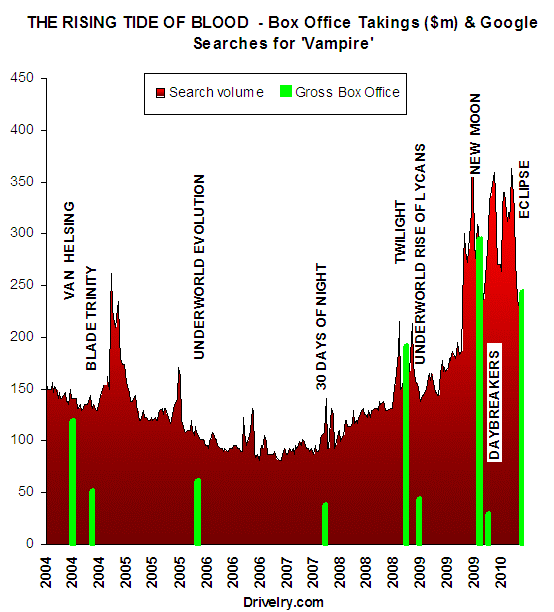This is the first part in a four part series looking at the extraordinary popularity of the vampire genre, Dracula being the subject of more films than any other fictional character. The four parts are:
- One hundred years of vampire films looks at the longevity of the vampire genre, the box office takings of some of the recent major vampire movies, and the surge in interest in the vampire genre over the last 10 years.
- Vampire origins: the price of immortality examines how the vampire genre prods our sensitivities about death and aging, and builds on a wealth of known Christian religious symbolism.
- Vampires selling unsafe sex? looks at the thinly-veiled, yet Rated-M sexual metaphors of the vampire genre and the way it has tracked the sexual interests of various generations, from the Victorian period to the swinging Sixties, and the recent focus on adolescence and virginity.
- Vampirism ‘the bloodborne disease’ focuses on the recent medicalization of vampire stories and the zombie/vampire crossovers, paralleling popular fears of bloodborne diseases like hepatitis and AIDS.
Does the vampire live forever?
 Northrop Frye the Canadian literary academic had a theory that there are only a few plots that get endlessly recycled in different stories.
Northrop Frye the Canadian literary academic had a theory that there are only a few plots that get endlessly recycled in different stories.
Looking at the vampire genre it sounds pretty plausible because there are just so many vampire story and film variations.
IMDB actually includes 685(!) vampire-related movies dating back to the silent era around 1910 (including foreign language and ‘straight to video’ releases) some of which are tempting just because of the sheer ridiculousness of their titles. Fancy “Batman Fights Dracula’ (1967) for example? Or in an equally light-hearted ‘vein’ how about the recent “Vampires Suck” parody complete with its ‘Team Jacob’ and ‘Team Edward’ (the two male protagonists in Eclipse & New Moon) references?
Even if you just stick to more major titles you end up with about 284 vampire movies (based on a list at Washington State University, Updated) made over the last 100 years. AND about sixteen vampire movies scheduled for 2011.
Bram Stoker and Dracula’s children
Thinking back even just over the last 20 years there is an amazing range of variations on the standard vampire plot:
- Bram Stoker’s Dracula (1992) based closely on the the 1897 novel that really started the modern vampire film. Directed by Francis Ford Coppola, with Keanu Reeves and a certain amount of thinly disguised moaning from Winona Ryder, the more sophisticated film took double its US box office takings from foreign Box Office earnings and is still one of the biggest vampire blockbusters of all time.
- other thoughtful vampire flicks like 1987’s underrated Near Dark cowboy version or 2007’s Rise (might be described as ‘intellectual vampire movies’)

- race exploration crossovers like Eddie Murphy’s Vampire in Brooklyn (1995), itself a remake of a 1972 black Dracula movie Blacula, (a nice attempt to re-colonize the ‘whites only’ vampiric world) or True Blood’s (2008) strong references to race issues in the American South.
- vampires in space and Alaska: 2007’s 30 Days of Night embedded in a claustrophobic snowbound world
- splatter-fests/martial versions like 1996’s From Dusk Till Dawn set in a stripper’s bar, or 1998’s Blade with Wesley Snipes and its equally commercially successful sequels

- Tom Cruise’s Interview with the Vampire (1994), based on the Anne Rice novels, an imagined less European (and more American) history of vampires (“we can have cultured vampires in America”)
- adolescence and vampirism going back to 1987’s The Lost Boys, Buffy the Vampire Slayer (1992) and Twilight (2008)
- combo horror with Vampires v Werewolves: Underworld (2003), and the New Moon (2009) and Eclipse (2010) instalments of the Twilight series
- borderline zombie/vampire variations (zombies are not ‘undead’ but infected
 with a bloodborne virus): 2002’s 28 Days Later or 2006’s Ultraviolet
with a bloodborne virus): 2002’s 28 Days Later or 2006’s Ultraviolet - ‘bleed-through’ vampire sub-plots in TV series like Supernatural, Doctor Who, Smallville, Charmed and The Simpsons to of course being the main plotline in series like True Blood (2008) or The Vampire Diaries (2009)
Take your fangs off my wallet
Huge interest in vampires equals huge earnings at the box office and in associated merchandizing (Amazon is currently even selling ‘Bella Swan Replica Jewelery’). Box Office Mojo estimates total vampire flick box office earnings at almost $2 billion since 1978 and puts the average takings of each vampire movie at over $35m, making a vampire film one of the safer bets a movie producer can take.
Based on Google Trends data (going back to 2004) the level of search interest in the term ‘vampire’ has more than doubled over the last 5 years, with significant peaks coinciding with the Twilight phenomenon (major vampire title release dates and their level of box office takings shown in green).
Both Underworld: Rise of the Lycans and Daybreakers might well have done better had they not coincided with the two Twilight Saga release dates.
The Twilight series has also joined another select group: that of films where the sequels have grossed more than the originals such as the Lord of the Rings film trilogy.
Why do we (and Bella Swan) love vampires?
No doubt having a decent looking lead actor like Robert Pattinson or Taylor Lautner is helpful but vampires also play to our obsessions about disease, mortality and sex. It’s a potent mix and one that will be considered in the next article in this series.
Love them or hate them, the vampire theme is important in our culture.
It will be interesting to see which fiction series will form the next vampire cinema blockbuster or TV series. Place your bets below.
This article filed under the following 'Interest' categories (click category for more) Cliche watch, Reviews
Article posted by @Drivelry on July 15, 2010
Filed under topics (click for more articles on that topic): film review, movies, vampires
